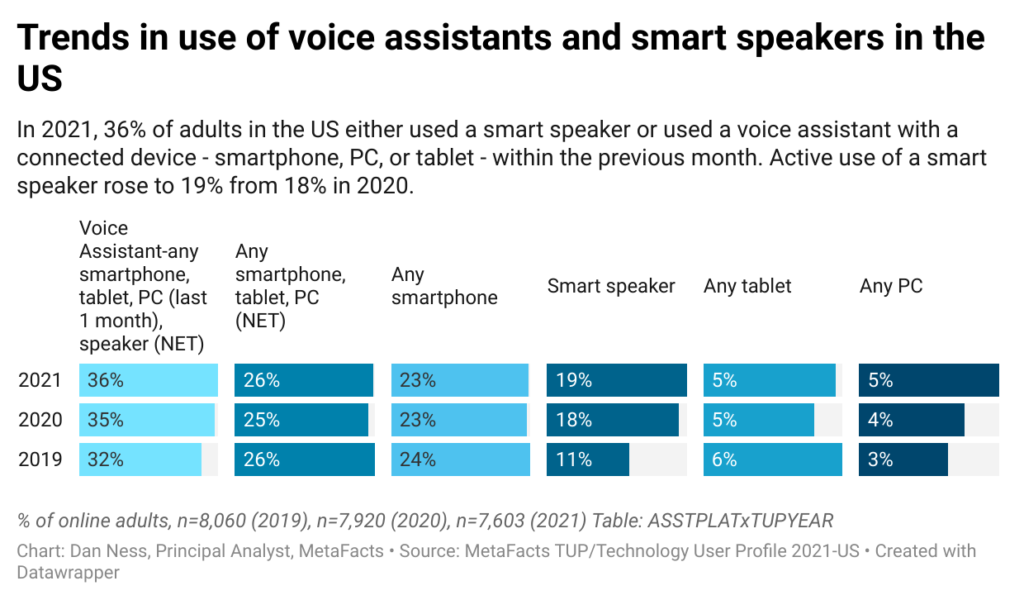Listening and hearing activities with connected devices are widely practiced. To help, online Americans use many hearables devices: webcams, voice assistants, wireless Bluetooth headsets, smart speakers, VR headsets, or smart displays. This includes 143.9 million online American adults, or two in three (66%). This MetaFAQs reports on the active penetration rates of these audio-oriented devices split by age group and details the rapidly-changing adoption rates by life stage.
What are the major listening activities across countries?
Who’s listening? And to what? Most online adults report having used any connected device for specific listening and hearing activities within the previous month (ranging from 87-95% of online adults, depending on country). Regularly making personal phone calls dominates as the most popular listening activity in every country surveyed, and video calls have reached the halfway mark.
This MetaFAQs reports on listening activities (including phone calls, videos/movies, video calls, music/radio/podcasts, television, video games, video meetings, voice assistants, and voice memos) by country: the US, UK, Germany, and Japan in 2021.
Profile of voice assistant users
Using our voice offers the chance to get things done without typing when using a smart speaker or another connected device – smartphone, PC, or tablet. However, current usage has not reached even half of the population. This MetaFAQs reports on the percentage of online adults in the US, Germany, UK, and Japan that regularly use a voice assistant or smart speaker, detailed by age group.
Smart speakers among young and old
How deeply have smart speakers penetrated technology users’ lives? From 2019 to 2021, has market penetration shifted very much? Which age group has adopted smart speakers more quickly and deeply than others? How different is this in the US than in the UK or Germany or Japan? This TUP analysis reports on the percentage of online adults that actively use a smart speaker.
Breadth of voice assistant usage
Dan Ness, Principal Analyst, MetaFacts, December 13, 2021
Actively using a voice assistant or smart speaker
- This analysis focuses on those people who are actively using a voice assistant or smart speaker
- Have used a connected device to use a voice assistant within the previous month
- Smartphone, PC, or tablet
- Have a smart speaker
- Have used a connected device to use a voice assistant within the previous month
- Base: all online adults
Active voice assistant usage by platform – US
- The overall use of a voice assistant or smart speaker has only slightly increased between 2019 and 2021
- Smart speaker usage has grown the most among American online adults, rising from 11% in 2019 to 19% in 2021
- Voice assistant usage with other connected devices has not changed markedly
- Voice assistant usage with a smartphone continues to outpace smart speaker use

Paid streaming music listening among socioeconomic groups
Listening to paid streaming music grew markedly among Americans, rising from 29% of online Americans in 2019 prior to the pandemic and reaching 36% in 2021. This MetaFAQs reports on the percentage of Americans regularly using their connected devices for paid streaming music by socioeconomic group. The groups being reported consider age group, employment status, household size, ethnicity, presence of children, educational attainment, and other socioeconomic factors.
Wearables penetration by country
Wearables have moved into the mainstream, reaching the wrists and ears of half of Americans. Penetration rates are not as high among online adults in Germany, the UK, or Japan. Also, smartwatches are not universally adopted. This MetaFAQs reports on the penetration rate of Bluetooth headsets, smartwatches, and electronic activity trackers among online adults by country.
Smart watch penetration among socioeconomic groups
Active use of a smartwatch grew strongly among Americans, rising from 20% of online Americans in 2018 prior to the pandemic and reaching 27% in 2021. Growth has not been uniform, however, as some groups have penetration of two-thirds where others are less than five percent. This MetaFAQs reports on the percentage of Americans regularly using a smartwatch by socioeconomic group. The groups being reported consider age group, employment status, household size, ethnicity, presence of children, educational attainment, and other socioeconomic factors.
Voice-enabled wireless speakers by age group [MetaFAQs]
Which age groups use voice-enabled wireless speakers the most? Online Americans use wireless speakers to use voice commands with Siri or Alexa or to listen to music, and the penetration rates vary substantially by age. This MetaFAQs reports on the penetration of voice-enabled speakers by age group among adults the US. This MetaFAQs uses results from the TUP/Technology User Profile 2020, which is TUP’s 38th annual.
Headsets – our sound islands [TUPdate]
Dan Ness, Principal Analyst, MetaFacts – December 10, 2020
Wireless Bluetooth headsets get a booster
Wireless Bluetooth headsets have been in the news lately, widely promoted as a year-end gift accessory. As a category, they have been available for decades, so why the latest emphasis, and is there enough demand for them?
Market demand has gotten stronger during 2020 in large part due to changed playing and working conditions. With the pandemic and stay-at-home restrictions worldwide, many people are now nearby a distinct set of people than they might interact with at their workplace or school. While quarantines can be a bonding experience, there can be added pressure when the sounds we make or listen to impinge on others.
Listening widespread, although differs by device type
Beauty is in the eye of the beholder, or perhaps the ear. The music some may consider beautiful may seem like noise to others. Similarly, the phone call we may think thoughtful may sound to others like distracting chatter.

